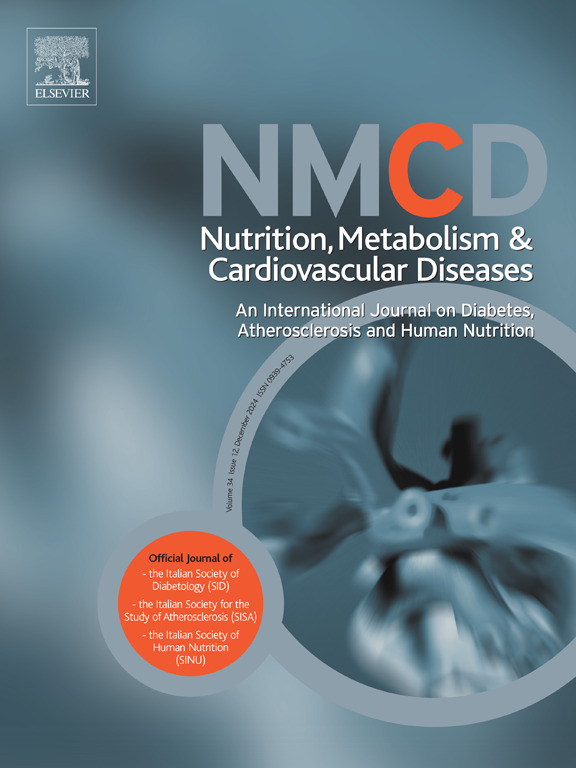Trajectories of activities of daily living/ instrumental activities of daily living and the risk of cardiovascular diseases
IF 3.3
3区 医学
Q2 CARDIAC & CARDIOVASCULAR SYSTEMS
Nutrition Metabolism and Cardiovascular Diseases
Pub Date : 2025-03-06
DOI:10.1016/j.numecd.2025.103969
引用次数: 0
Abstract
Background and aim
Prior research has reported the association between activities of daily living (ADL)/instrumental activities of daily living (IADL) of cardiovascular disease (CVD). We aimed to identify distinctive ADL/IADL trajectories and evaluate their relationship of the risk of CVD.
Methods and results
Our analysis included 7717 participants with four ADL/IADL assessments from the China Health and Retirement Longitudinal Study. Trajectories of ADL/IADL were identified by latent mixture modeling. Cox proportional hazards regression models were used to examine the association of ADL/IADL trajectories with CVD risk (stroke or cardiac events).
Three distinct ADL/IADL trajectory groups were identified: maintaining a low ADL/IADL score throughout the follow-up (low-low trajectory); low starting ADL/IADL scores then increasing to mild scores (low-mild trajectory), and mild starting ADL/IADL scores then increasing (mild-increasing trajectory). During a median follow-up of 24 months (23 months-25months), a total of 519 respondents experienced CVD (including 143 stroke and 394 cardiac events). Individuals with low-mild and mild-increasing ADL trajectory were significantly associated with higher risk of CVD, with the corresponding hazard ratios were 1.50(1.24–1.81) and 2.02(1.44–2.84), respectively, compared to the individuals with low-low IADL trajectory. Similarly, individuals with low-mild and mild-increasing IADL trajectory were associated with 29 % (hazard ratios = 1.29, 95 % confidence intervals 1.06–1.58) and 59 % (hazard ratios = 1.59, 95 % confidence intervals 1.13–2.22) increased risk of CVD. Furthermore, Individuals with low-mild and mild-increasing ADL/IADL trajectory also had higher risks of stroke and cardiac events.
Conclusion
Individuals with low-mild and mild-increasing ADL/IADL trajectory over time were associated with increased risk of incident CVD.
日常生活活动/工具性日常生活活动轨迹与心血管疾病风险。
背景与目的:已有研究报道了日常生活活动(ADL)/日常生活工具活动(IADL)与心血管疾病(CVD)之间的关系。我们的目的是确定不同的ADL/IADL轨迹,并评估它们与CVD风险的关系。方法和结果:我们的分析包括来自中国健康与退休纵向研究的4项ADL/IADL评估的7717名参与者。利用潜在混合模型识别ADL/IADL的运动轨迹。使用Cox比例风险回归模型来检查ADL/IADL轨迹与CVD风险(中风或心脏事件)的关联。确定了三种不同的ADL/IADL轨迹组:在整个随访期间保持较低的ADL/IADL评分(低-低轨迹);低起始ADL/IADL评分再升高至轻度(低-轻度轨迹),轻度起始ADL/IADL评分再升高(轻度-升高轨迹)。在中位随访24个月(23 -25个月)期间,共有519名受访者经历了CVD(包括143例中风和394例心脏事件)。与低-低ADL轨迹者相比,低轻度ADL轨迹者和轻度ADL轨迹者患CVD的风险显著增高,其风险比分别为1.50(1.24-1.81)和2.02(1.44-2.84)。同样,低轻度和轻度增加的IADL轨迹与29%(风险比= 1.29,95%置信区间为1.06-1.58)和59%(风险比= 1.59,95%置信区间为1.13-2.22)的CVD风险增加相关。此外,低轻度和轻度增加ADL/IADL轨迹的个体也有更高的卒中和心脏事件风险。结论:随着时间的推移,ADL/IADL轨迹低轻度和轻度增加的个体与CVD发生风险增加相关。
本文章由计算机程序翻译,如有差异,请以英文原文为准。
求助全文
约1分钟内获得全文
求助全文
来源期刊
CiteScore
6.80
自引率
2.60%
发文量
332
审稿时长
57 days
期刊介绍:
Nutrition, Metabolism & Cardiovascular Diseases is a forum designed to focus on the powerful interplay between nutritional and metabolic alterations, and cardiovascular disorders. It aims to be a highly qualified tool to help refine strategies against the nutrition-related epidemics of metabolic and cardiovascular diseases. By presenting original clinical and experimental findings, it introduces readers and authors into a rapidly developing area of clinical and preventive medicine, including also vascular biology. Of particular concern are the origins, the mechanisms and the means to prevent and control diabetes, atherosclerosis, hypertension, and other nutrition-related diseases.

 求助内容:
求助内容: 应助结果提醒方式:
应助结果提醒方式:


